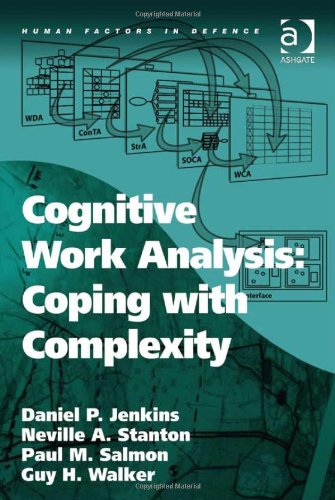

Most ebook files are in PDF format, so you can easily read them using various software such as Foxit Reader or directly on the Google Chrome browser.
Some ebook files are released by publishers in other formats such as .awz, .mobi, .epub, .fb2, etc. You may need to install specific software to read these formats on mobile/PC, such as Calibre.
Please read the tutorial at this link. https://ebooknice.com/page/post?id=faq
We offer FREE conversion to the popular formats you request; however, this may take some time. Therefore, right after payment, please email us, and we will try to provide the service as quickly as possible.
For some exceptional file formats or broken links (if any), please refrain from opening any disputes. Instead, email us first, and we will try to assist within a maximum of 6 hours.
EbookNice Team

Status:
Available0.0
0 reviews
ISBN 10: 0754670260
ISBN 13: 9780754670261
Author: Daniel P Jenkins, Neville A Stanton, Paul M Salmon, Guy H Walker
'Complex sociotechnical systems' are systems made up of numerous interacting parts, both human and non-human, operating in dynamic, ambiguous and safety critical domains. Cognitive Work Analysis (CWA) is a structured framework specifically developed for considering the development and analysis of these complex socio-technical systems. Unlike many human factors approaches, CWA does not focus on how human-system interaction should proceed (normative modelling) or how human-system interaction currently works (descriptive modelling). Instead, through a focus on constraints, it develops a model of how work can be conducted within a given work domain, without explicitly identifying specific sequences of actions (formative modelling).
The framework leads the analyst to consider the environment the task takes place within, and the effect of the imposed constraints on the way work can be conducted. It provides guidance through the process of answering the questions of why the system exists, what activities can be conducted within the domain as well as how these activities can be achieved, and who can perform them.
The first part of the book contains a comprehensive description of CWA, introducing it to the uninitiated. It then presents a number of applications in complex military domains to explore and develop the benefits of CWA. Unlike much of the previous literature, particular attention is placed on exploring the CWA framework in its entirety. This holistic approach focuses on the system environment, the activity that takes place within it, the strategies used to conduct this activity, the way in which the constituent parts of the system (both human and non-human) interact and the behaviour required. Each stage of this analysis identifies the constraints governing the system
Chapter 1 Introduction
Why CWA for Command and Control?
Structure of the Book
Chapter 2 It’s a Complex World
Introduction
Complexity
Command and Control C2
What Makes CWA Different From Other Human Factors Methods?
The Framework
Framework for Conducting CWA
Work Domain Analysis
Control Task Analysis
Strategies Analysis
Social Organisation and Cooperation Analysis
Worker Competencies Analysis
Chapter Summary
Chapter 3 Interaction Design
Chapter Introduction
Interface Design or Interaction Design?
Interface Design Principles
Developing Displays
Grouping Displays
Physical and Functional Interfaces
Metaphoric References
When Mental Models are Incorrect
Standardise Approaches
What are We Designing? – A Case Study for Military Planning
Chapter Summary
Chapter 4 Application of CWA in Familiar Domains
Chapter Introduction
An iPod
Introduction
The Analysis
Work Domain Analysis
Control Task Analysis
Strategies Analysis
Conclusions
Chapter Summary
Chapter 5 Applications of CWA in a Complex World
Chapter Introduction
Design – CWA of Rotary Wing Military Mission Planning System
Data Collection
Analysis Results
Conclusions
Evaluation – Using Work Domain Analysis to Evaluate the Impact of Digitisation on Command and Control
Method
Results
Conclusions
Chapter Summary
Chapter 6 Using CWA to Design for Dynamic Allocation of Function
Chapter Introduction
CWA of the Sensor to Effecter Paradigm
The Domain
The Analysis
Conclusions
Design for the Sensor to Effecter System
Chapter Summary
Chapter 7 Designing Interfaces Using CWA
Chapter Introduction
New Warfare
Effects Based Operations (EBO)
The Comprehensive Approach
Synthesising CWA and EBO
Benefits of This Type of Representation
A Contemporary Planning Approach
Development of Visualisation Ideas
The Synthesis of EBO and CWA
Display Ideas
Experiments
Phase 1 – Interpretation of Existing Displays
Phase 2 – Ease of Generation and Usability of Displays
Experimental Conclusions
Chapter Summary
Chapter 8 Development of a CWA Software Tool
Introduction
Why Do We Need a Software Tool?
What Should the Tool Do, and How Should It Do It?
The Benefits of the Tool
Using the Tool
Analysis Information
Phase 1 – Work Domain Analysis (WDA)
Phase 2 – Control Task Analysis (ConTA)
Phase 3 – Course of Action / Strategies Analysis (StrA)
Phase 4 – Social Organisation and Cooperation Analysis (SOCA)
Phase 5 – Worker Competencies Analysis
Compilation
Summary
Chapter Summary
Chapter 9 Does the Tool Make the CWA Process any Quicker or Easier?
Chapter Introduction
CWA of an Armoured Battlegroup in the Quick Attack
The Analysis
Conclusions
Chapter Summary
Chapter 10 Conclusions
Is CWA Useful for the Analysis, Development and Evaluation of ‘Command and Control’ Systems?
Can It Cope with Complexity and Different Units of Analysis (Artefacts to Dynamic Systems)?
What Are the Limits of CWA?
Developments and Directions for Future Work
Linking the Phases
Extending CWA
Closing Remarks
Appendix: Can it be Taught?
Bibliography
Index
cognitive work analysis book
workbook for cognitive skills
5-word cognitive test
4 e cognitive science
4-e cognitive science framework
the cognitive behavioral workbook for anxiety a step-by-step program
Tags: Daniel P Jenkins, Neville A Stanton, Paul M Salmon, Guy H Walker, Cognitive, Analysis